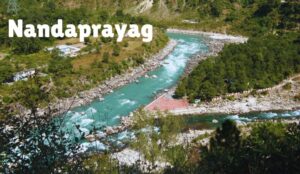Are you looking for a unique spiritual journey that takes you to a hidden gem in the Himalayas? Well, look no further! We invite you to discover the mystical world of Budha Madmaheshwar, a place where spirituality and nature intertwine in the most beautiful way.🏔️🌄🙏
About Budha Madmaheshwar
The Budha Madmaheshwar temple in Uttarakhand’s Garhwal Himalayas is dedicated to Lord Shiva. It’s believed that the Pandavas, characters from the Mahabharata, built this temple.
It sits at a high altitude of 3497 meters and is part of the Panch Kedar pilgrimage circuit, which includes four other Shiva temples: Kedarnath, Tungnath, Rudra Nath (to visit before Madmaheshwar), and Kalpeshwar (to visit after).
Budha Madmaheshwar temple is just 2 kilometers from the Madmaheshwar temple and offers stunning views of the Chaukhambha peaks. It’s a special place for Shiva devotees and is also known as Mahadev.
The Magical Story
Imagine a place where Lord Shiva once revealed his divine form to Lord Buddha. That’s the essence of Budha Madmaheshwar. It’s a spot that’s steeped in Hindu mythology and radiates a special spiritual energy. Pilgrims from all corners of the world are drawn to this sacred place.
The Enchanting Temple
At the heart of Budha Madmaheshwar lies an ancient temple that’s simply awe-inspiring. Its architecture, with its intricately carved stone walls, is a sight to behold. Inside, you’ll find the ‘Lingam,’ a symbol of Lord Shiva, where devotees come to offer their prayers.
What to Expect
As you approach the temple, the air is filled with the soothing chants of ‘Om Namah Shivaya.’ People offer flowers, incense, and milk to the Lingam, seeking blessings for themselves and their loved ones. It’s a place where you can find inner peace.
Nature’s Bounty
Beyond its spiritual significance, Budha Madmaheshwar is a nature lover’s paradise. Imagine lush green meadows, colorful wildflowers, and clear blue skies framing majestic peaks. You can get in touch with nature there in its most unadulterated state.
Flora and Fauna
The region is a haven for biodiversity enthusiasts. It’s not uncommon to spot exotic Himalayan birds like the Monal Pheasant and Himalayan Monal. The dense forests are inhabited by the elusive Himalayan musk deer and the agile Himalayan tahr. Nature lovers will find solace in the harmonious coexistence of spirituality and the environment.
How To Reach
- Reach Rishikesh: Start your journey by reaching Rishikesh, which is well-connected by road to major cities like Delhi and Dehradun.
- Drive to Ukhimath: From Rishikesh, take a road trip to Ukhimath, which is approximately a 7-8 hour drive. This is a scenic route that will take you through beautiful landscapes in the Garhwal region.
- Trek or Arrange Transportation to Gaundar Village: Budha Madmaheshwar temple is not directly accessible by road. You’ll need to either trek from Ukhimath to Gaundar Village, which takes about 2-3 days and involves moderate difficulty trekking, or you can inquire about local transportation options like jeeps or mules.
- Trek to Budha Madmaheshwar: From Gaundar Village, it’s a relatively short 2-kilometer trek to reach the Budha Madmaheshwar temple. The trek is manageable for most visitors, but do ensure you’re prepared with appropriate trekking gear and supplies.
When to Go Budha Madmaheshwar
Planning your pilgrimage to Budha Madmaheshwar requires careful consideration of the weather and the trekking conditions. Here’s a seasonal breakdown to help you choose the best time for your visit:
1. Spring (May – June):🌼
- Weather: Spring is one of the most pleasant times to visit Budha Madmaheshwar. Days are mild, and the temperatures range from 10°C to 20°C.
- Scenery: The surroundings come alive with colorful wildflowers in full bloom, creating a picturesque landscape.
- Trekking Conditions: Trails are relatively clear of snow, making it easier to trek. Rivers and streams are also at manageable levels.
- Spiritual Experience: The moderate weather allows for a comfortable and spiritually enriching journey.
2. Summer (July – August):🌞
- Weather: Summers in the Himalayas can be unpredictable. Daytime temperatures range from 15°C to 25°C, but heavy monsoon rains can disrupt your plans.
- Scenery: The lush greenery is at its peak during this time, but the rains can obscure mountain views.
- Trekking Conditions: Monsoon brings the risk of landslides and slippery trails. It’s not the ideal time for trekking due to safety concerns.
3. Autumn (September – October):🍁
- Weather: Autumn is another fantastic time to visit Budha Madmaheshwar. The days remain comfortable with temperatures between 10°C and 20°C.
- Scenery: The monsoon washes away the dust, offering crystal-clear mountain views. The foliage turns into shades of gold and red.
- Trekking Conditions: Trails are in excellent condition, making trekking safer and more enjoyable.
- Spiritual Experience: With favorable weather and stunning landscapes, this is the peak season for pilgrimages.
4. Winter (November – April):❄️
- Weather: Winters in the Himalayas are harsh, with temperatures plummeting below freezing. Snowfall is common.
- Scenery: Snow blankets the region, creating a serene but challenging environment.
- Trekking Conditions: Trekking during winter is not recommended for beginners. Snow-covered trails are demanding and require specialized gear.
- Spiritual Experience: While the temple remains open for worship throughout the year, winter is mainly for experienced trekkers and ardent devotees willing to face extreme conditions.
What to Bring: Essential Items for Your Journey
Planning a pilgrimage to Budha Madmaheshwar? Here’s a list of essential items you should bring along to ensure a comfortable and memorable journey:
- Sturdy Trekking Gear: Invest in reliable trekking shoes with good ankle support. You’ll be traversing uneven terrain, so comfortable and durable footwear is a must. Don’t forget to break them in before your trip to prevent blisters.
- Warm Clothing: Even during the warmer months, temperatures in the Himalayas can drop unexpectedly. Pack layers, including thermal wear, a fleece jacket, and a waterproof outer layer to stay warm and dry.
- Backpack: Opt for a comfortable, lightweight backpack with adjustable straps. It should have enough space to carry your essentials, including water, snacks, and spare clothing.
- Water and Purification: Staying hydrated is crucial at high altitudes. Carry a reusable water bottle and purification tablets or a portable filter to ensure access to safe drinking water during your trek.
- First-Aid Kit: Prepare a basic first-aid kit with essentials like adhesive bandages, antiseptic wipes, pain relievers, and any personal medications you may require. It’s better to be prepared for minor injuries or discomfort.
- Navigation Tools: Bring a reliable map of the trekking route or consider a GPS device. While local guides are available, having a backup navigation tool can be helpful.
- Trekking Poles: These can provide stability and reduce strain on your knees, especially during steep ascents and descents.
- Headlamp/Flashlight: In case you need to navigate in the dark or during early morning hours, a headlamp or flashlight is invaluable.
- Sun Protection: Protect yourself from the strong Himalayan sun with sunglasses, sunscreen (SPF 30+), and a wide-brimmed hat.
- Snacks and Energy Food: High-energy snacks like nuts, energy bars, and dried fruits will keep your energy levels up during the trek.
- Personal Identification: Carry a copy of your identification, travel permits, and emergency contact information in a waterproof pouch.
- Cash: While electronic payment methods may not be available on the trek, it’s wise to carry some cash for incidentals or emergencies.
- Camera/Smartphone: Capture the breathtaking landscapes and memories of your journey with a camera or smartphone. Don’t forget extra batteries or a portable charger.
- Respectful Attire: Remember, you’re visiting a sacred site. Dress modestly, covering your shoulders and knees, and remove your shoes before entering the temple.
- Devotion and Patience: Lastly, carry an open heart, a spirit of devotion, and patience. A pilgrimage to Budha Madmaheshwar is not just about the physical journey; it’s a spiritual one that requires inner preparation.
Nearby Places to Explore
- Madmaheshwar Temple: The main Madmaheshwar temple is just 2 kilometers away and is a must-visit. It’s another sacred shrine dedicated to Lord Shiva and offers a unique spiritual experience.
- Kedarnath: Kedarnath, one of the holiest Hindu shrines, is part of the Panch Kedar circuit. It’s located about 20 kilometers from Madmaheshwar and can be reached by trekking or hiring a local guide.
- Tungnath Temple: Tungnath is another important temple in the Panch Kedar circuit and is known for its stunning mountain views. It’s reachable by trekking from Chopta, which is a scenic drive from the Budha Madmaheshwar temple.
- Chopta: Chopta is often called the “Mini Switzerland of India” due to its picturesque landscapes. Trekkers and those who enjoy the outdoors will appreciate it here. The trek to Tungnath and Chandrashila Peak starts from here.
- Deoria Tal: Deoria Tal is a beautiful lake surrounded by lush forests and offers a peaceful setting. It’s not far from Ukhimath and can be visited as a day trip.
- Kalpeshwar Temple: As part of the Panch Kedar circuit, you can also visit Kalpeshwar Temple, dedicated to Lord Shiva, after Budha Madmaheshwar. It’s known for its tranquil atmosphere.
- Chandrashila Peak: If you’re an avid trekker, consider trekking to Chandrashila Peak from Chopta. It provides panoramic views of the Himalayan range and is especially popular during winter for its snow-covered landscapes.
- Rudra Nath Temple: Rudra Nath is another significant temple in the Panch Kedar circuit. It’s located in a pristine location and is dedicated to Lord Shiva.
In Conclusion
Budha Madmaheshwar isn’t just a place; it’s an experience. It’s where spirituality meets nature in a truly magical way. As you embark on this adventure, may you discover not only the divine but also a deeper connection with yourself and the world around you.
FAQs Related to Budha Madmaheshwar
1. Is trekking required to reach Budha Madmaheshwar Temple?
Yes, trekking is necessary to reach the temple, as it’s not directly accessible by road. The trek is approximately 2 kilometers from Gaundar Village and is moderate in difficulty.
2. Is there accommodation available near Budha Madmaheshwar Temple?
Accommodation options near the temple are limited, but you can find guesthouses and small lodges in nearby villages like Ransi and Ukhimath. Booking in advance is advised, especially during the busiest season for pilgrimages.
3. What is the significance of the Panch Kedar circuit?
The Panch Kedar circuit consists of five sacred temples dedicated to Lord Shiva, including Budha Madmaheshwar. Pilgrims undertake this circuit to seek the blessings of Lord Shiva and to complete a spiritually significant journey.
4. Are there any specific rituals or customs to be followed when visiting the temple?
Visitors are expected to dress modestly and remove their shoes before entering the temple premises. It’s customary to offer prayers and perform aarti (rituals involving lighted lamps) to seek the deity’s blessings.
5. What precautions should I take when trekking to Budha Madmaheshwar Temple?
When trekking to the temple, carry essentials like water, snacks, warm clothing (if visiting in colder months), and comfortable trekking shoes. It’s also advisable to check the weather forecast and inform someone about your trekking plans for safety.





